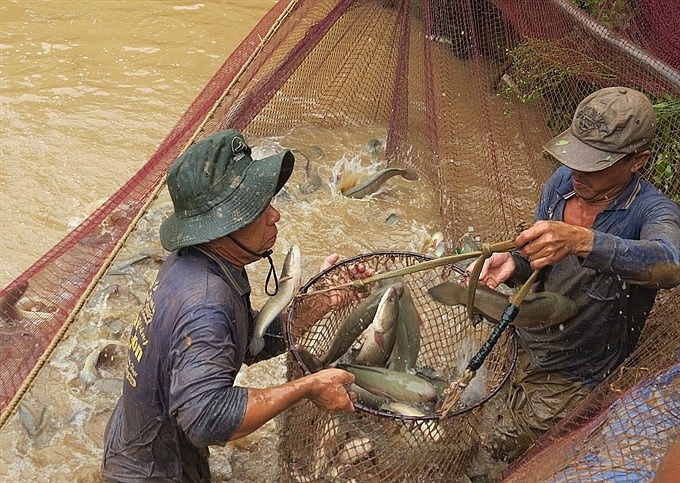Dong Thap to release floodwater into rice fields
 |
| Farmers in the Mekong Delta’s province of Dong Thap take advantage of the flooding season to breed fish, shrimp and other aquatic species and grow other aquatic crops. - VNA/VNS Photo Chuong Dai |
The release of water will not affect the production of other fields.
Farmers and local authorities will give suggestions about the time and quantity of flood water that should be released, according to the province’s Department of Agriculture and Rural Development.
The delta’s annual floods are caused by the rising water levels of the Mekong Delta in the rainy season.
Nguyen Thanh Hung, vice chairman of the provincial People’s Committee, said last year the province released flood water into more than 113,600 ha of rice fields.
The flooding helps destroy germs, reduces the cost of improving the fertility of the fields and helps crops grow.
Dong Thap authorities have also carried out measures to protect summer-autumn rice and other crops from waterlogging.
In Hong Ngu District, one of the hardest-hit flooding areas in Dong Thap, local authorities and farmers have strengthened rice protection dykes and set up teams to monitor dykes and sluices.
The district has set up 28 rescue teams to protect agricultural production and people in case of emergency.
Floodwaters have caused damage to dozens of hectares of vegetables and crops in alluvial grounds in Hong Ngu District.
Le Thi Loan in the district’s Long Khanh A Commune said her 2,000sq.m of cabbage fields were inundated by floodwaters.
She estimated a loss of about VND8 million (US$350) in her investment into this field.
Flood benefits
The annual floods enrich fields with sediment, support fisheries and aquatic ecosystems, and offer a livelihood for many farmers.
Farmers take advantage of the flooding season to breed fish, shrimp and other aquatic species and grow other aquatic crops like lotus and water lily.
Locals also catch fish and other aquatic species during the flooding season and harvest other wild crops.
Common sesban, water lily, linh fish and other aquatic species are specialities of the delta’s flood season.
Nguyen Van Duc Em, who harvests common sesban in the flooding season in Hong Ngu District’s Thuong Phuoc 2 Commune, said his family gets up at 2am to pick common sesban for selling and now earns an income of VND500,000 -700,000 ($22 - 30) a day from harvesting the flower.
Common sesban is sold for VND60,000 – 70,000 ($2.6 - 3) a kilo.
Bui Thi Suong has been harvesting fish and other aquatic species in Hong Ngu District’s Thuong Thoi Hau A Commune in the "rising water" season for more than 10 years.
“Every year I look forward to the flooding season,” she said.
Hong Ngu and Tan Hong districts, as well as Hong Ngu Town, are the province’s upstream areas where floods occur first.
As floods arrived early this year and the water level is higher, fishermen are preparing tools to catch fish.
Phan Van Trieu, who catches shrimp in Hong Ngu District’s Thuong Thoi Hau B Commune, is making several dozen new shrimp traps, which he considers to be better than store-bought traps.
Producers that produce tools for catching fish and other aquatic species in Dong Thap said the demand for tools is about two times higher than in non-flooding areas. Fishing nets are the most popular item.
Ngo Phuc Loc, who makes fishing tools in Lai Vung District’s Long Hau Commune, said his establishment produces more than 100 fishing nets a day at a cost of VND120,000 – 200,000 ($5 – 8.8) each.
In Hong Ngu Town’s Binh Thanh Commune, 100 households who make bamboo crab traps are selling to locals and exporting to Cambodia.
Truong Thanh Hung, who has made bamboo crab traps in Binh Thanh for 10 years, said he makes more than 1,000 traps every year during flooding season.
The traps sell for VND28,000 – 30,000 ($1.2 – 1.3) each and producers can earn a profit of VND10,000 – 15,000 from each trap, he said.
“The sale of bamboo crab traps is high from now to September,” he said.
What the stars mean:
★ Poor ★ ★ Promising ★★★ Good ★★★★ Very good ★★★★★ Exceptional
 Tag:
Tag:
Related Contents
Latest News
More News
- Second banh mi festival slated for May (April 23, 2024 | 17:09)
- PM asks for prompt actions to fix consequences of serious workplace accident in Yen Bai (April 23, 2024 | 12:09)
- HCM City’s public high schools cut back on admissions in 2024-2025 academic year (April 23, 2024 | 12:05)
- SLP Vietnam inaugurates rural road solar lighting project in Long An (April 19, 2024 | 07:12)
- Vietnam needs 20-30 billion USD investment for universal clean water access (April 16, 2024 | 17:10)
- Vietnam Airlines adjusts flight paths via Middle East (April 16, 2024 | 17:05)
- Vietnamese community in India stays united, contributes to homeland (April 15, 2024 | 11:42)
- Dien Bien Phu Victory celebrated in France (April 15, 2024 | 11:37)
- Vietnamese Embassy in Israel issues warning amid escalating tension (April 15, 2024 | 08:00)
- ADB forecasts 6 per cent growth for Vietnam (April 12, 2024 | 17:17)






















 Mobile Version
Mobile Version